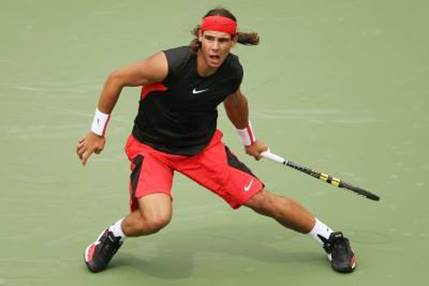Athletes and coaches must understand that tennis requires quick reactive responses in order to improve movement on the court. Tennis specific movement training must take into account the athlete’s strengths, weaknesses, and style of play. The movements of tennis players are different from many other sports. For example, the movement of a tennis player reacting to his opponent’s next shot is different from a wide receiver breaking from the line of scrimmage.
So what makes movement in tennis different from other sports?
In tennis the average point last less than 10 seconds. Recovery in between points lasts around 20-25 seconds and 90-second rest periods every two games. Knowing the style of movement in which tennis is played is critical to developing conditioning programs for high-level players. “Tennis players make an average of 4 directional changes per point but can range from a single movement to more than 15 directional changes on a very long point.”(Kovacs) It is normal for players to make up to 1,000 or more directional changes in a match.
The majority of tennis movements are side to side, which is important for trainers to focus on a player’s lateral acceleration and deceleration for developing ample movement ability on court. “In a study of professional players’ movement, it was found that more than 70% of movements in lateral direction less than 8% of movements in a backward direction.”(Kovacs) It is recommended that training time focuses 60-80% on lateral movements, 10-30% on forward movement, and only around 10% backward movement.
The game of tennis is evolving as the speed and power involved are constantly improving. Due to increased speeds players have adapted their split step movement. The split step was originally describes as both feet landing at the same time, however resent studies have shown that athletes actually land first with the opposite leg to the direction that they will move toward. For example, a right-handed player hitting a forehand would land first with their left foot as the support stance and then the right leg lands with the right hip turned to the direction of the next step.
How can this information be used to train athletes?
Trainers and coaches must understand the movement patterns of tennis. The movements of tennis players are different from other sports. Strengthening and training lateral movement patterns is critical in developing tennis players at every level of the game – junior, collegiate, professional, adult recreational, adult competitive and senior players.
Here are some exercises to help with lateral training:
- Lateral movement with medicine ball (MB) catch-This exercise is great to simulate movement laterally. In addition the MB helps the athlete visually to accelerate and decelerate to the MB.
- Side lateral mini hurdle runs- This plyometric exercise has athletes laterally hurdle through a set of small hurdles. Once through, the athlete must decelerate, stop and hold for a few seconds, then resume the exercise the opposite way.
- Lateral resistive running- Once an athlete has appropriate strength then they should incorporate this exercise. Have the athlete put on the waist-band and attach the other end of the elastic band to the fence. Have the athlete side shuffle low to the ground keeping the upper body balanced as the lower body drives against resistance.
- T-line to S-line shuffle- Have the athlete start at the center service mark. Side shuffle to the singles line and then back to the service mark. This exercise is about the same distance an athlete will travel before having to change directions.
Example of a lateral tennis-specific training session:
Please share some other exercises that you have found to be beneficial in developing lateral movement!
References
Kovacs, M., (2009). Movement for Tennis: The Importance of Lateral Training. Strength and Conditioning Journal, 31 (4), 77-85.








 RSS Feed
RSS Feed
